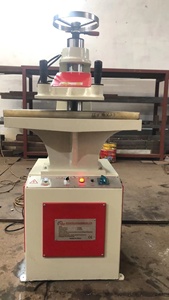(2722 products available)














































































































































































































Types of manual punching machines
The manual punching machine is available in different types and models to suit the requirements of various businesses in the machinery industry. The following types are popular among business buyers:
Pedal Punching Machine
The manual punching machine with a pedal is designed to operate with pedals. This heavy-duty machine can be used to punch different types of material, including metal and leather. High-quality steel is used to construct the frame of the machine, which ensures durability and sturdiness.
Handheld Hole Punch
Also known as the manual punch press or lever hole punch, this tool is designed for punching light materials like plastic and paper. It has a lever mechanism so the operator can use it conveniently. A complete press can be built around it for industrial purposes, or it can be used independently for lighter jobs.
Hydraulic Punching Machine
The hydraulic manual punching machine uses hydraulic power to move the ram and punch holes. It is also known as the hand-operated hydraulic punch press. The machine has a compact design that allows for easy mounting and dismounting of dies. The operator can quickly and accurately punch holes when cutting plates and other materials. Hoses, punches, and hydraulic controllers are some accessories used with this punching machine.
Hand Punching Press
This type of manual punching machine can handle lighter jobs. Users can place the material on the die and press down on the ram to create holes in the material.
Manual Grommet Press Machine
This handy machine is often used in the textile industry. It can be used to set grommets and also to punch holes in different materials, including leather, plastic, canvas, and rubber.
Many companies in the manufacturing industry use the manual punch press for numerous purposes. The machine is versatile and can work to shape a variety of materials. Industries that use the machine include:
The machines are great investments for small-scale businesses. Manual punching machines are inexpensive and easy to use. Workers can learn how to operate them quickly, and they do not require much training. Businesses interested in cutting and punching their materials precisely will benefit from investing in this machine.
Before investing in a punching machine, it is imperative to analyze various factors that drive demand in the industry. These include the capacity, operational benefits, and pricing of machines that can easily change to fit different material thicknesses. The material quality of the machine is also crucial, as no business can afford constant maintenance.
Understandably, all kinds of machines will have a preference for some material types over others. Businesses require large volumes of sheets, regularly punched holes, and consistency in quality to minimize operational costs. Therefore, it becomes essential to study the machine's capabilities for specific industries and applications. The market is saturated with hydraulic, pneumatic, knob-operated, and manual punching machines, all of which serve a purpose.
Consider whether there is a demand for straight cuts and irregular shapes in a business enterprise, including the weight of the sheet. Machines can smoothly cut through lighter, thin sheets, such as aluminum, galvanization, steel, etc., ranging from 0.5 mm to 3 mm. However, purchase costs can range in the thousands for an industrial-grade punching machine that only works with heavy-duty metal sheets. Consistency is key in industrial-grade machines. If a business primarily utilizes heavier gauge metal exclusively, it is better to invest in a hydraulic punching machine with a higher capacity that will provide long-term durability.
For industrial-grade machines, hydraulic/manual punch press price differences can be significant. A hydraulic punching machine requires less manual effort to operate and can efficiently handle larger workloads with heavy-duty sheets. A manual machine will be more affordable but requires more physical strength to operate. Employees will have to use hand-cranked gear to move the lever that punches the hole. Prioritizing greater capacity, a manual machine is suitable for less production where employees can take more time to operate the machine. Very few workplaces demand this level of effort. Because electric motors do not drive hydraulic machines, they are more energy efficient. Power consumption is low.
An important distinguishing factor when differentiating between machines is whether they are stand-alone or integrated into a production line. Stand-alone machines need to be brought back to focus on the tasks at hand. Integrated machines flow smoothly and continuously with the production line.
Q1: What is the warranty on a manual metal punching machine?
A1: Warranty details differ depending on the manufacturer or supplier. Buyers should discuss the warranty terms before purchasing the manual punching machine.
Q2: Does the manual punching machine come with any accessories?
A2: Some machines may come with accessories like different-sized punch heads or safety features. Check with the supplier to confirm.
Q3: Can custom designs of manual punching machines be made?
A3: Buyers can request changes to certain features of the machine, such as color or branding. However, usually, the machines are made in bulk and not with custom designs.
Q4: What are the safety precautions when using a manual punching machine?
A4: Operators should wear safety glasses and keep their hands/fingers away from the moving parts. Also, ensure that all safety guards are in place.